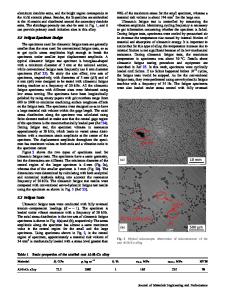Fatigue Crack Initiation Mechanism for Cast 319-T7 Aluminum Alloy
- PDF / 1,199,833 Bytes
- 9 Pages / 593.972 x 792 pts Page_size
- 56 Downloads / 479 Views
UCTION
IN an effort to find economical replacements for expensive wrought products, the use of aluminum-cast products has been increased recently as part of the structural component in aerospace and automotive industries.[1] The cast aluminum products, even with similar processing and testing conditions, show a wide range of fatigue lives with the presence of casting defects, such as porosity, oxide film inclusion, and second-phase particles, acting as easy crack initiators.[2–8] Previously, the authors used the linear elastic fracture mechanics (LEFM) approach, including use of the equivalent initial flaw size (EIFS) concept and the fatigue crack propagation rates, da/dN, as a function of either DK or DKeff, to predict the fatigue life of porosity-containing 319-T7 specimen.[9] It was found that the lineal relationship between the EIFS values from the fractographic analysis and the measured fatigue lives for 319-T7 specimen suggests that the EIFS, which is proportional to the porosity area, is a controlling factor for determining the fatigue life of cast aluminum alloy, if correctly chosen. The LEFM concept, including the use of EIFS value, back-calculated by using da/dN-DKeff data, successfully predicts the porosity-affected stress-life (S-N) fatigue behavior of cast 319-T7 specimens. Other than the porosity, the surface condition could affect the fatigue life, particularly for the cast products.[10–12] Jiang et al., YOUNGHWAN JANG and YOUIN JEONG, Research Engineers, are with the Research & Development Division, Korea Aerospace Industries, Ltd., Sachon 664-942, Korea. SANGUK JIN, Graduate Student, and SANGSHIK KIM, Professor, are with the School of Nano and Advanced Materials Engineering, Engineering Research Center, i-Cube Center, Gyeongsang National University, Chinju 660-701, Korea. Contact e-mail: [email protected] Manuscript submitted November 3, 2008. Article published online May 22, 2009 METALLURGICAL AND MATERIALS TRANSACTIONS A
for example, studied the effect of the surface roughness on the fatigue life of Al-7Si-Mg cast aluminum and reported that the removal of the rough cast surface could increase resistance to fatigue.[10] Similar observation was made in the work of Bayoumi et al.[11] The fatigue behavior of cast products is also sensitive to the location in castings with different solidification rates, causing the changes in dendrite arm spacing.[7] The effects of the surface condition and the location on the fatigue behavior were not considered in this study, and all the specimens were machined from the same location of the present cast products and mechanically polished. With the absence of pores and oxides in cast metal, fatigue cracks may initiate by persistent slip band mechanism.[3,13] Thin oxide films are often reported on the fatigue crack initiated area, presumably by the persistent slip band mechanism, and there exists quite a bit of controversy on the nature of these oxide layers.[13] The proposed causes of the oxide film with the persistent slip band mechanism are at present twofold: (1) the oxide is pre
Data Loading...











